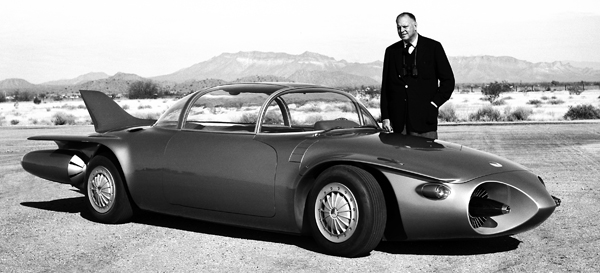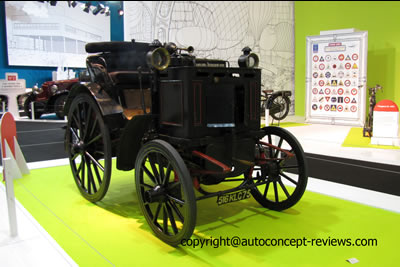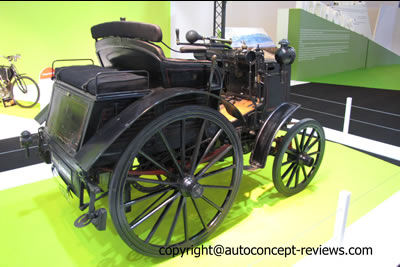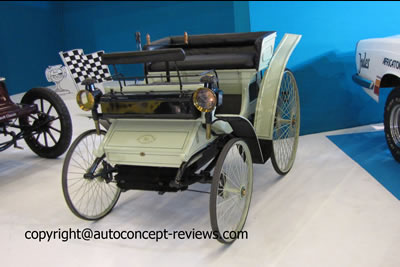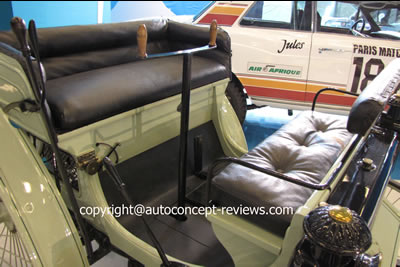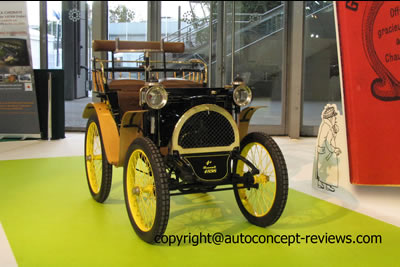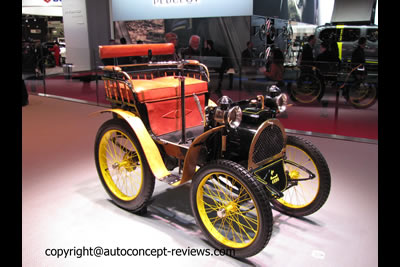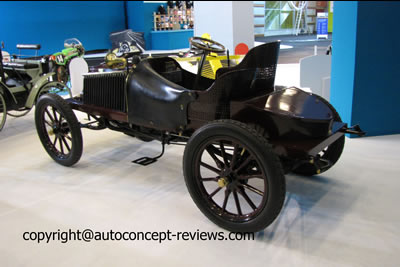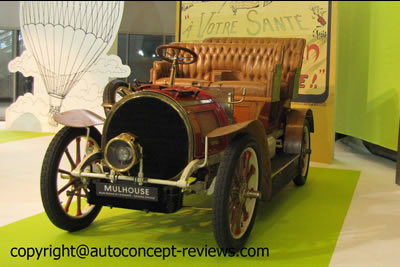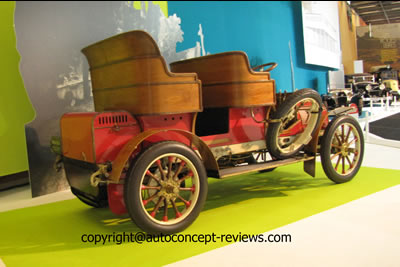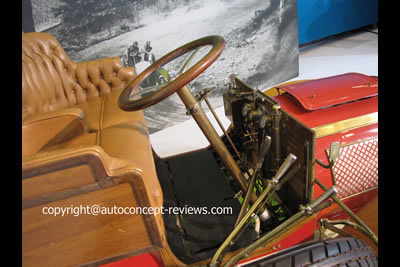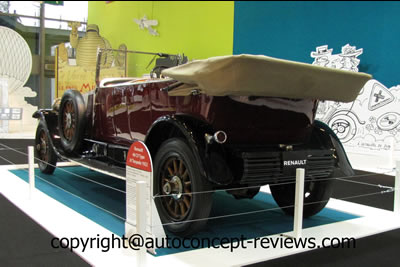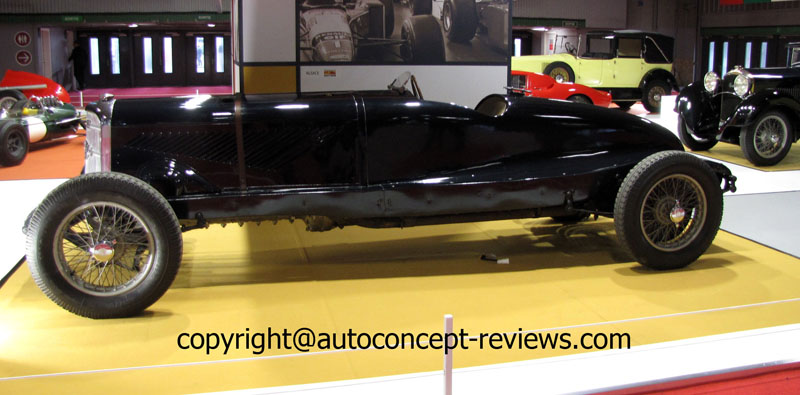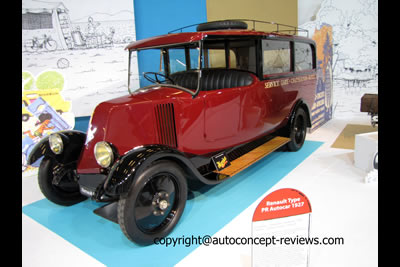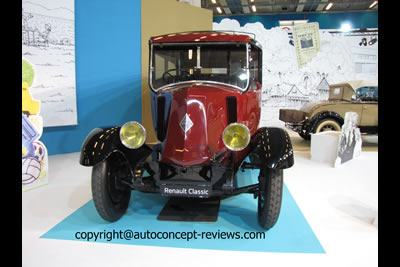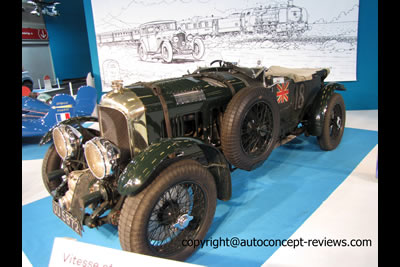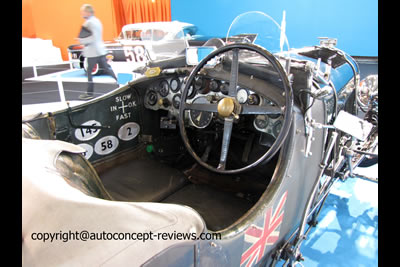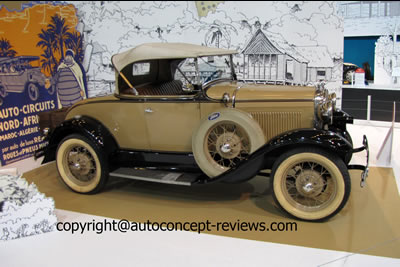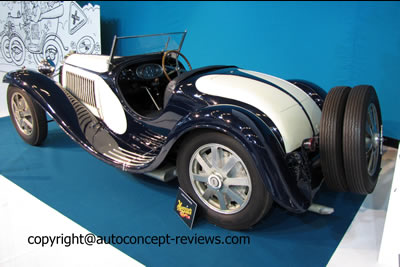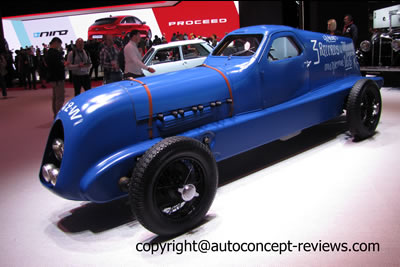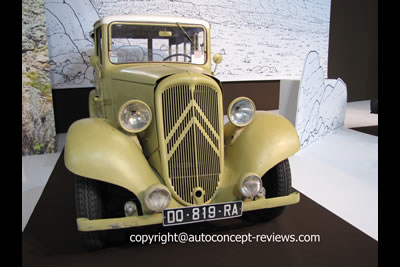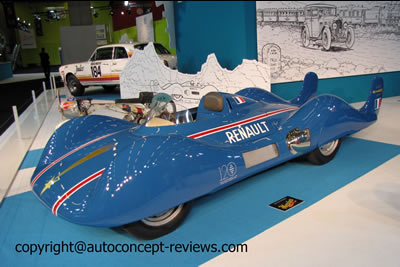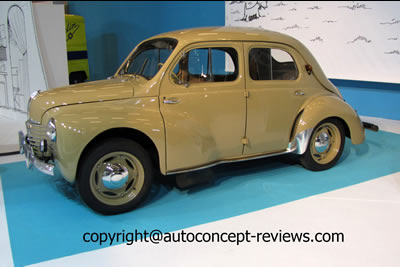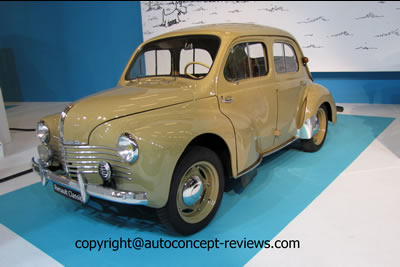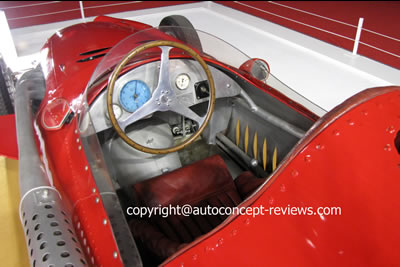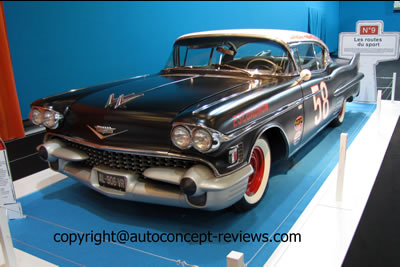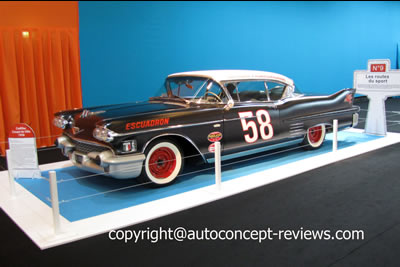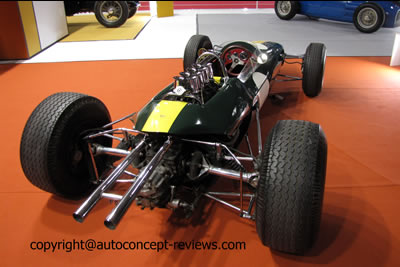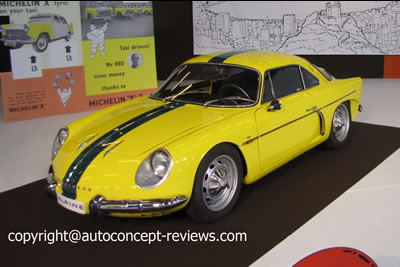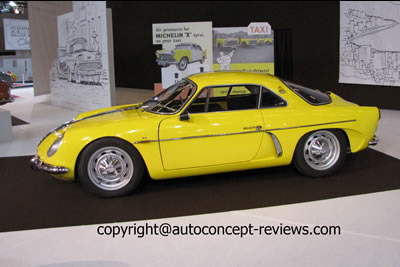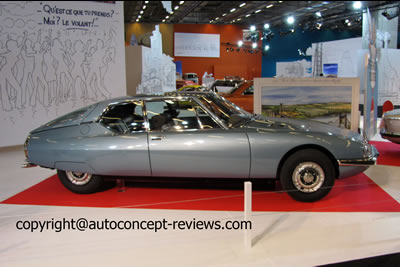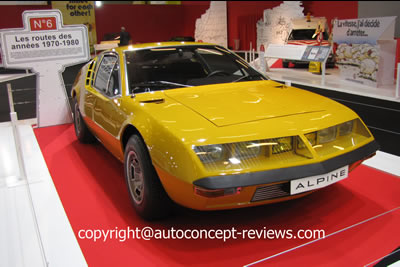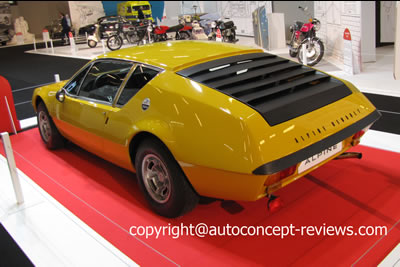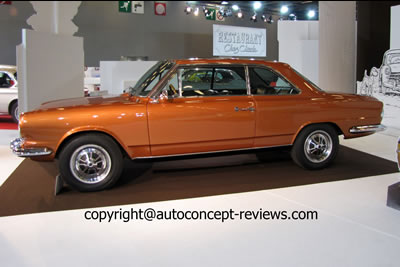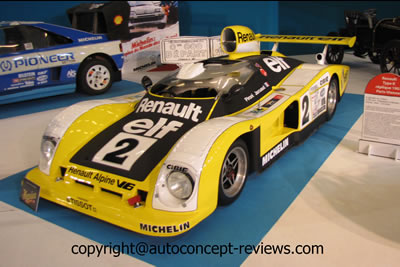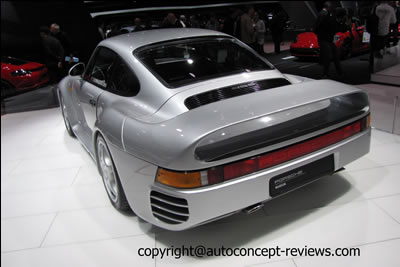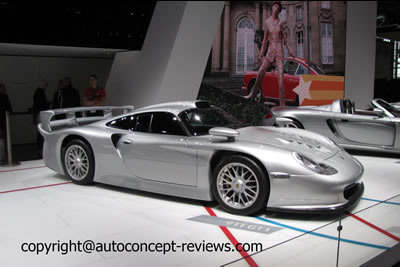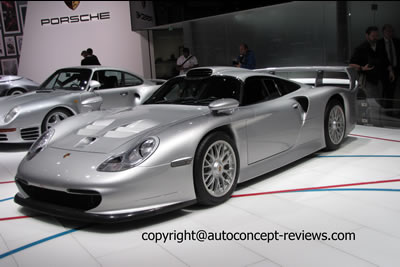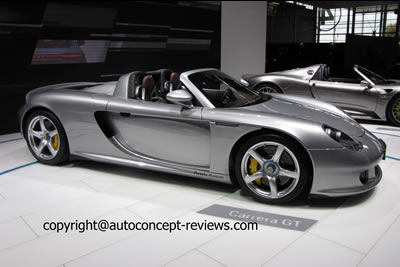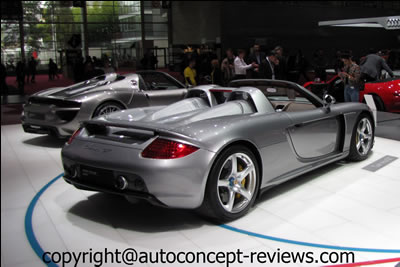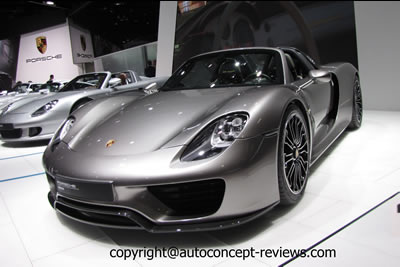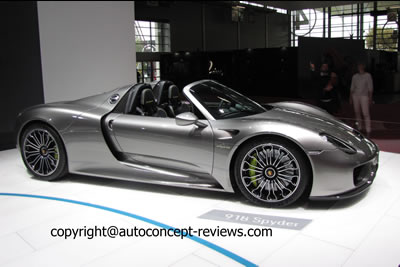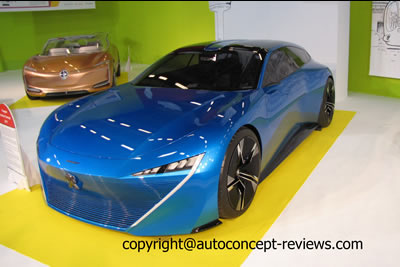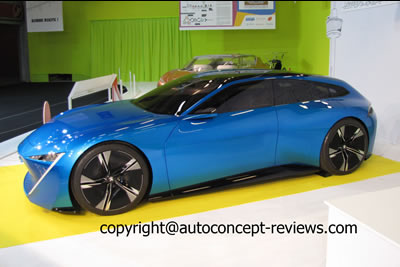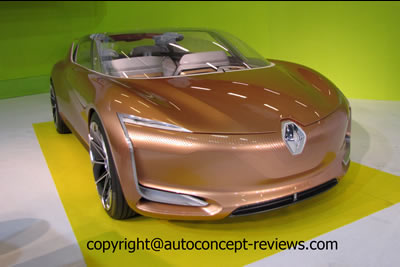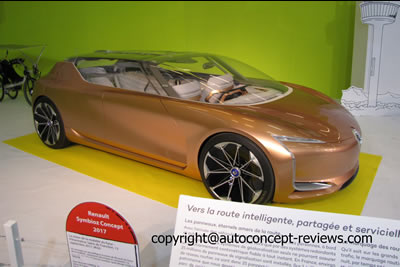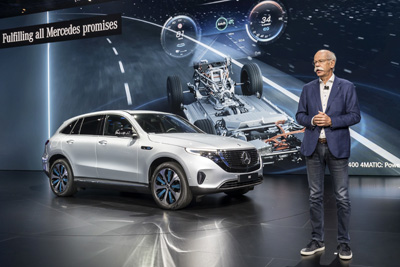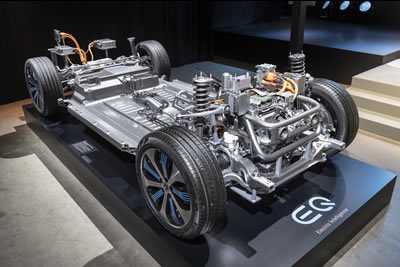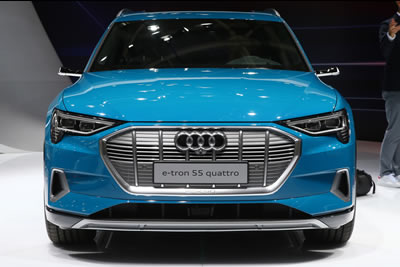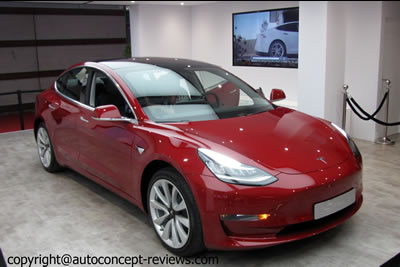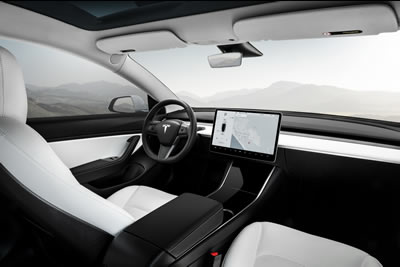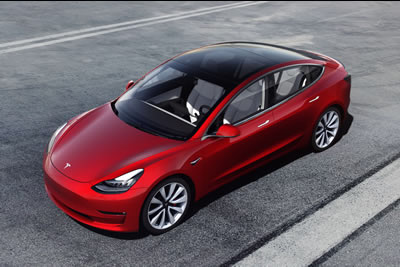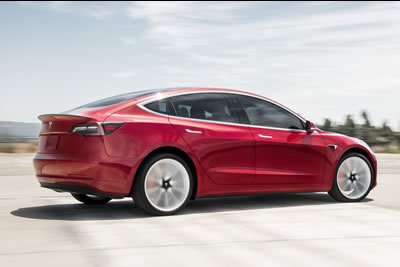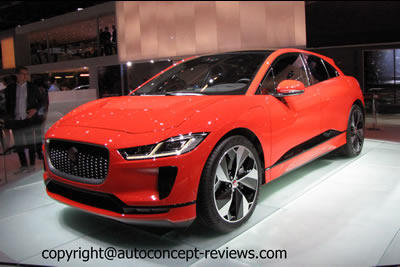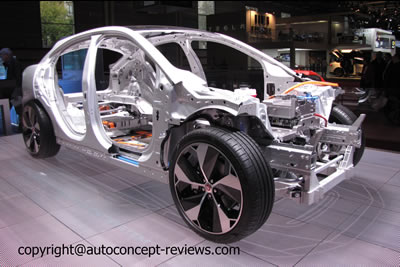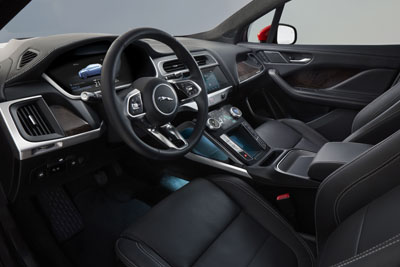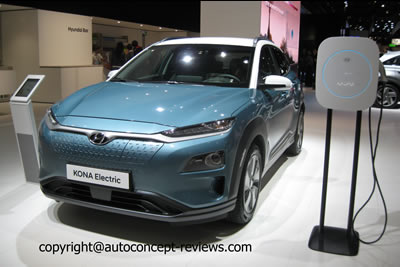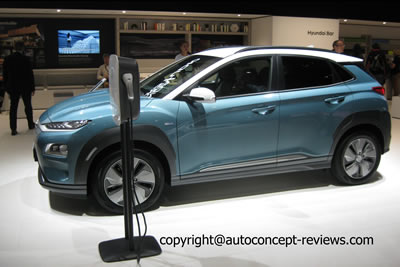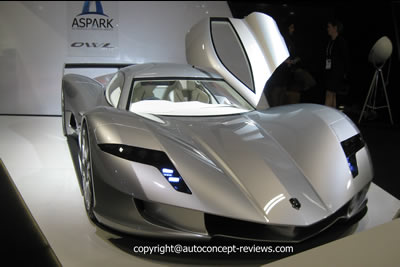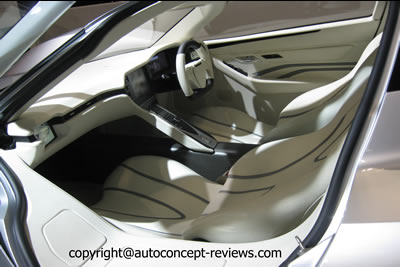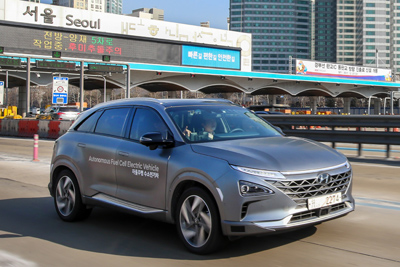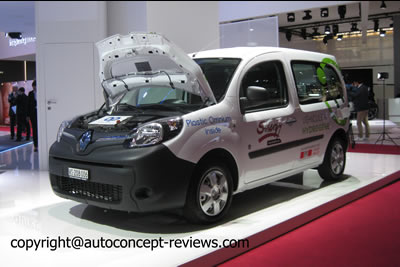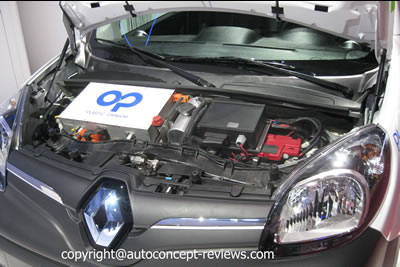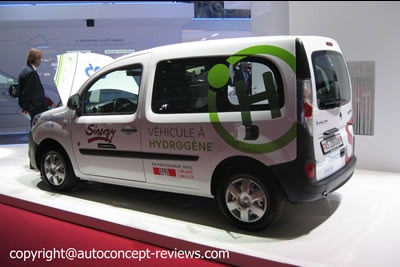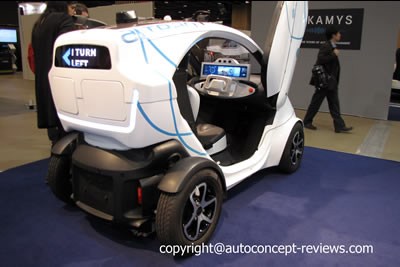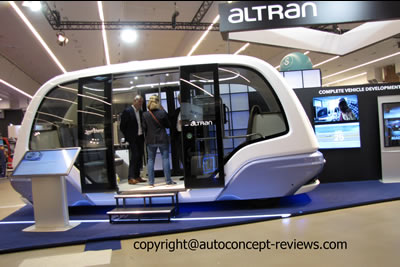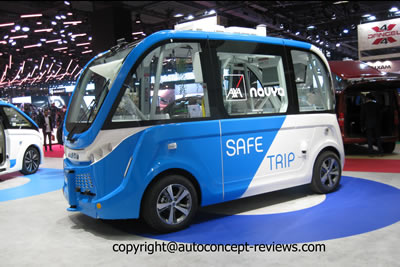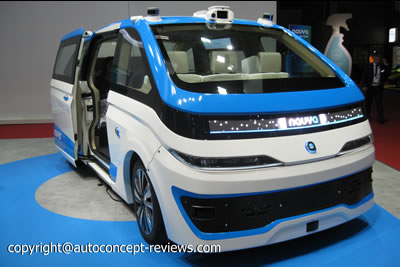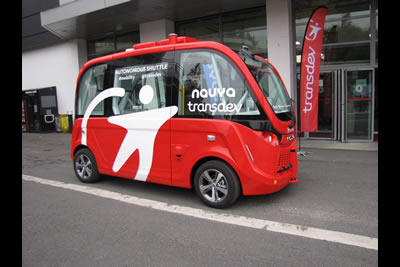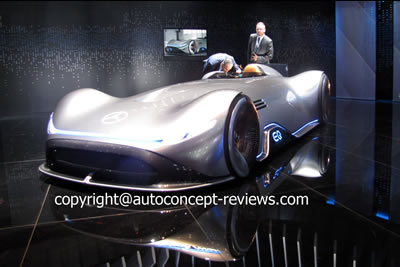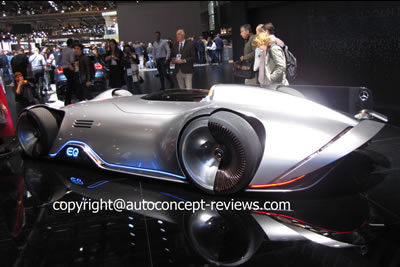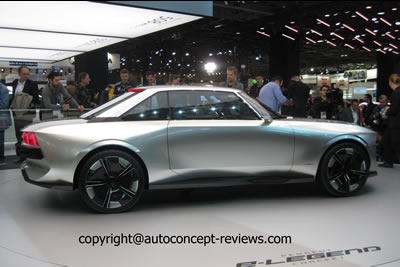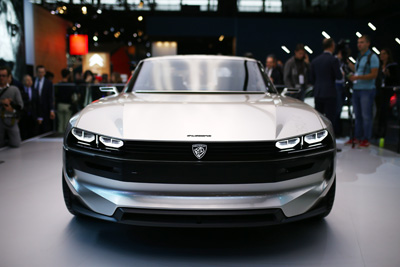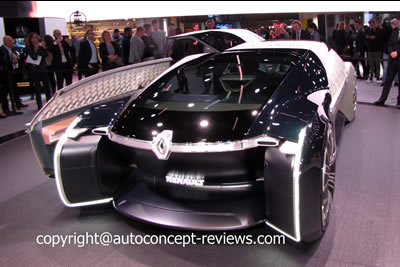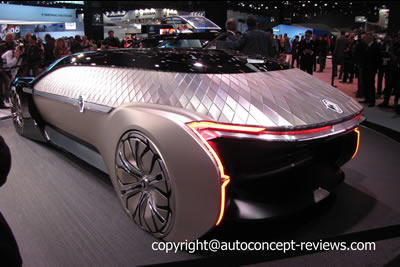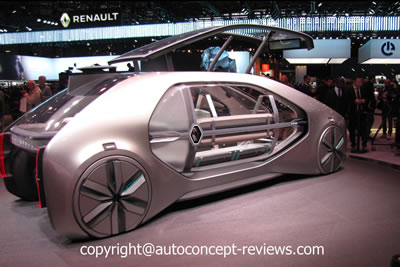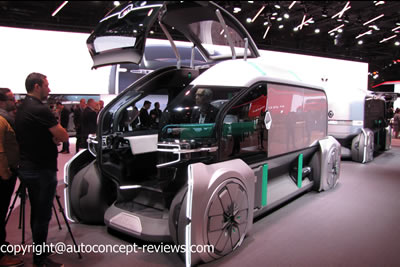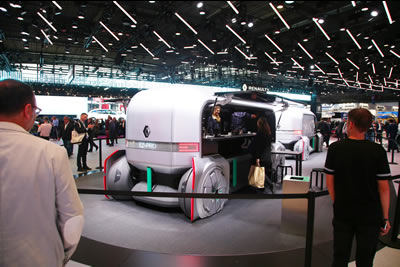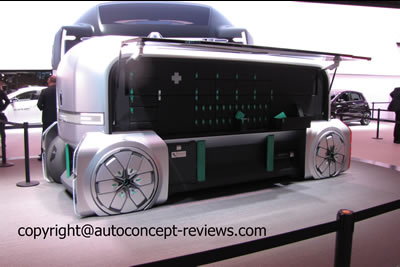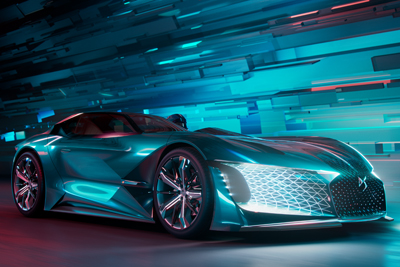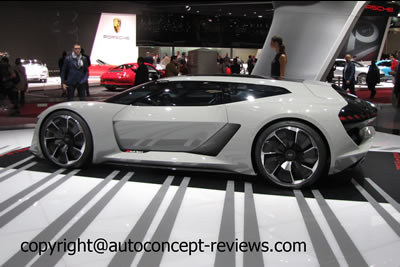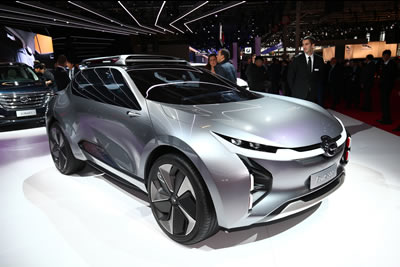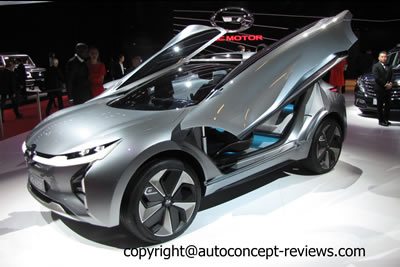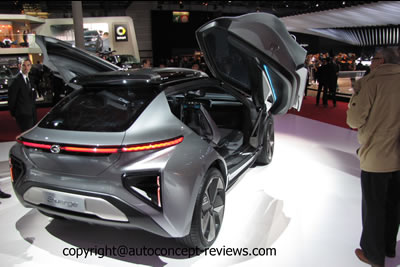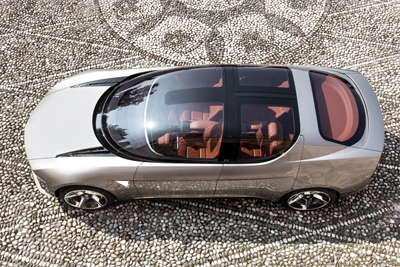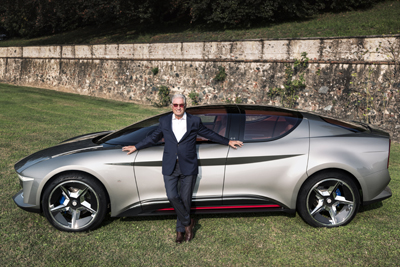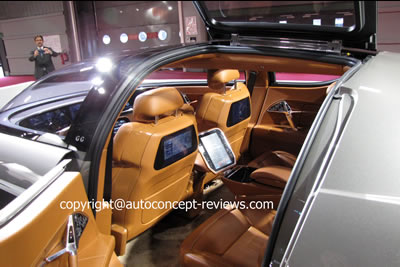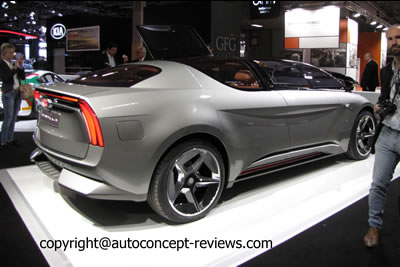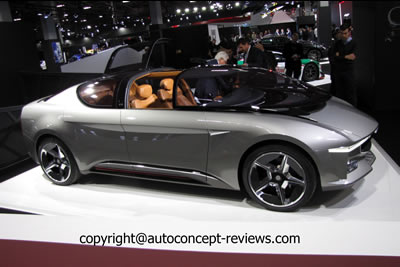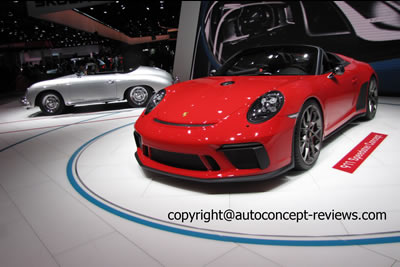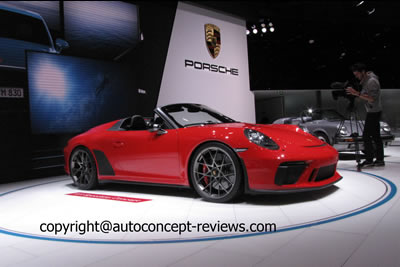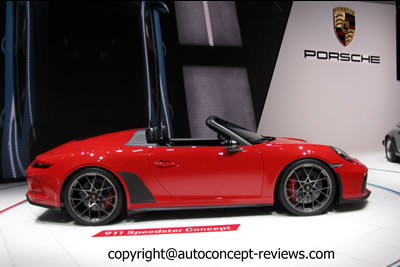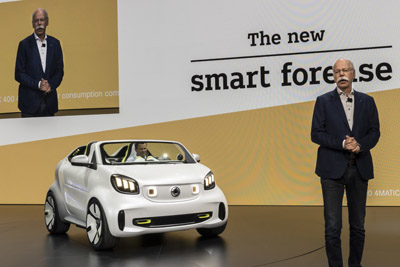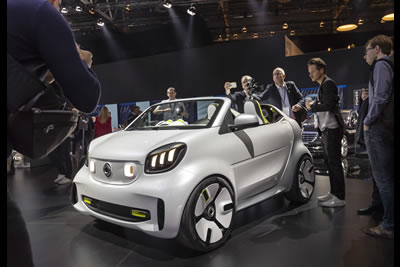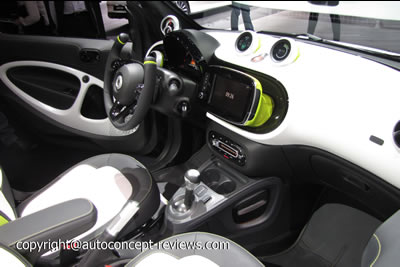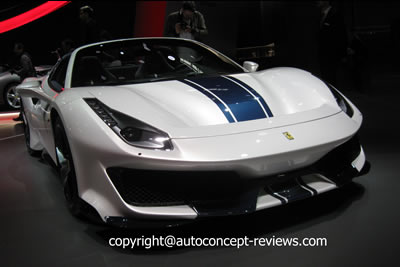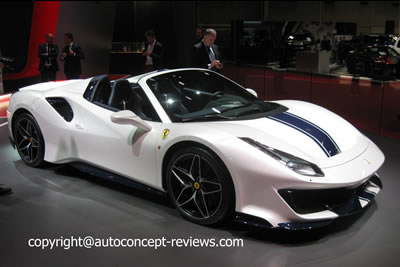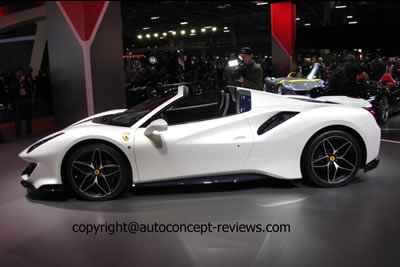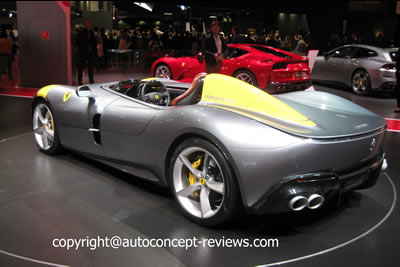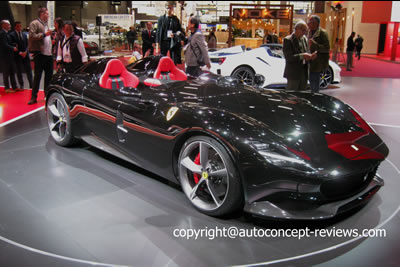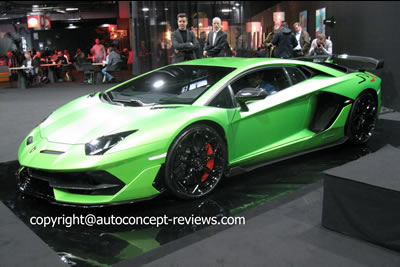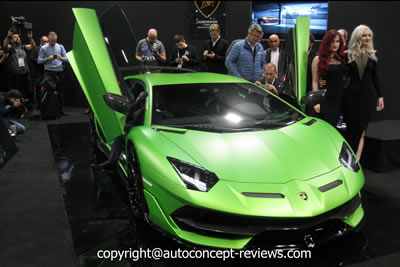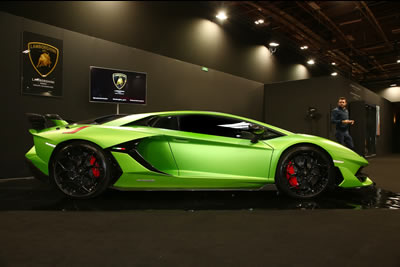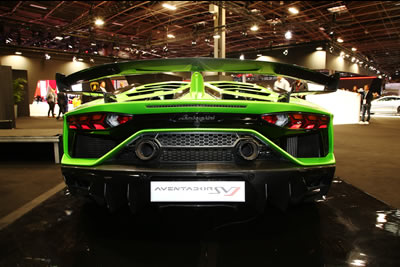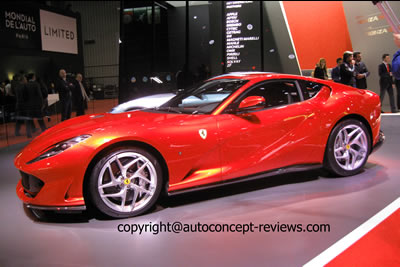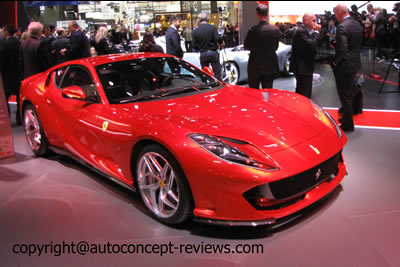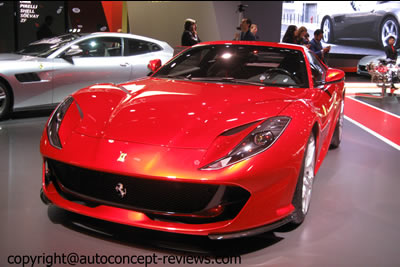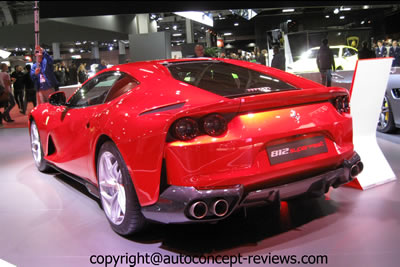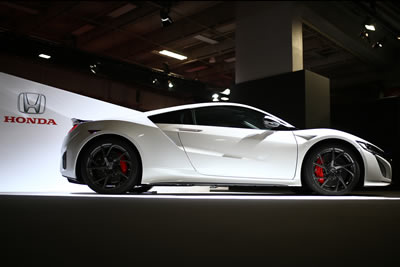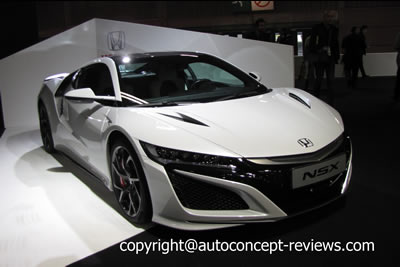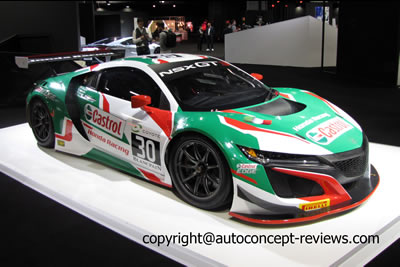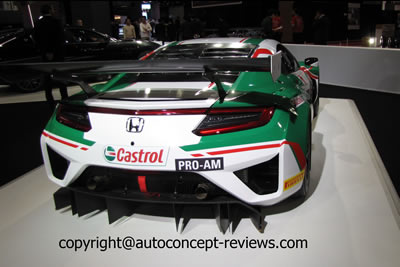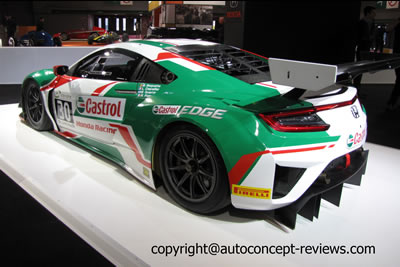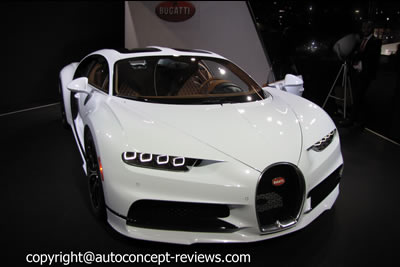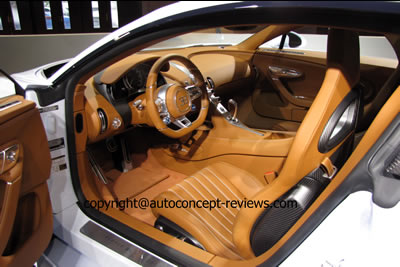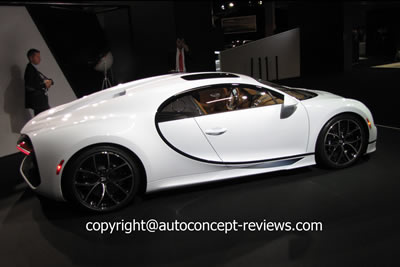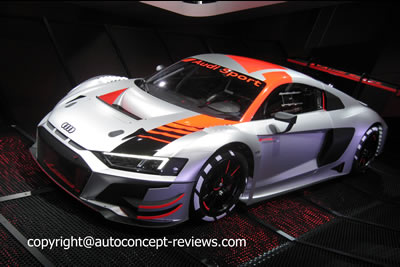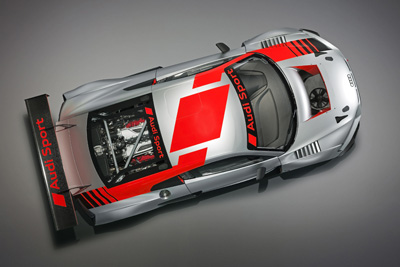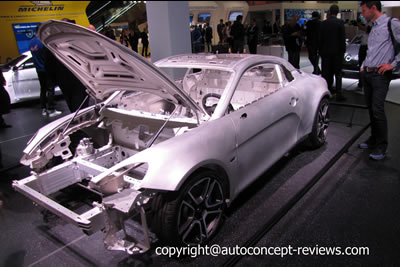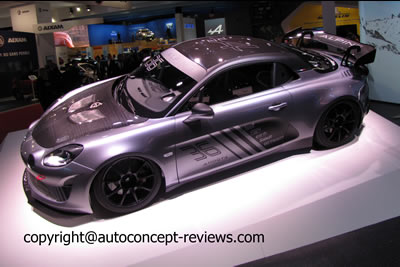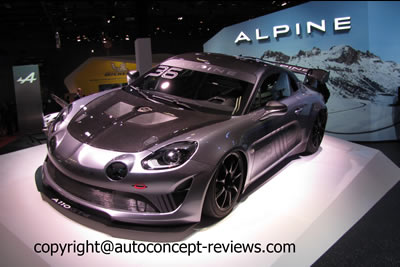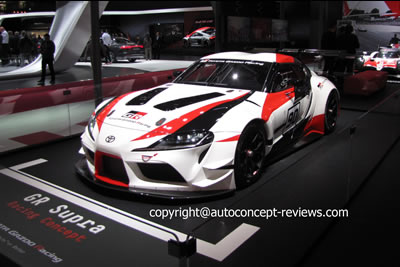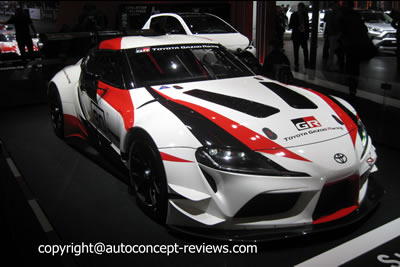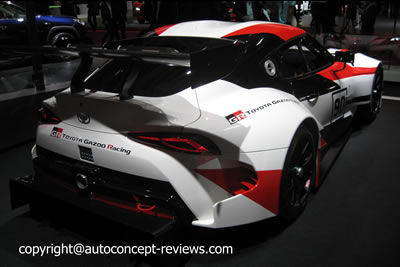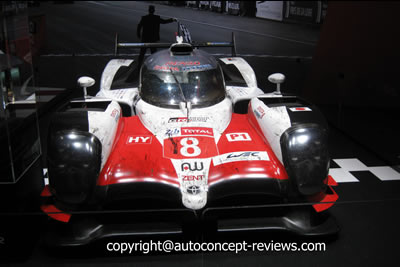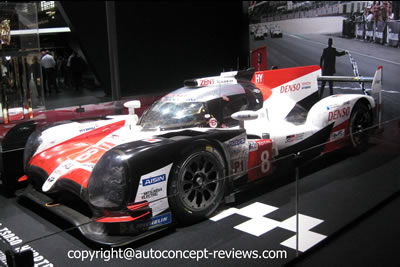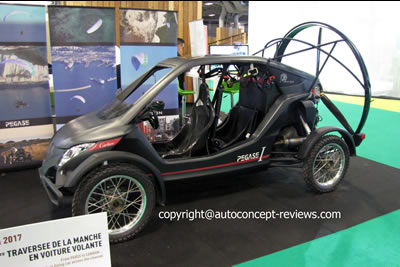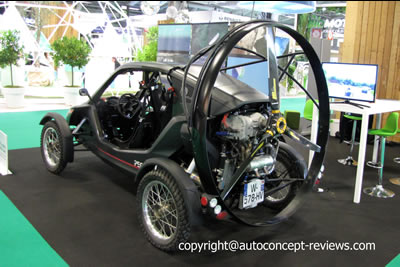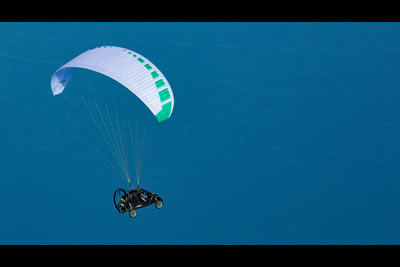- Paris, Mondial de l'Automobile 2018 -
120 Years Automobile history - Electric and Hydrogen Fuel Cell -Driverless Shuttle - Concept cars- Exclusive Cars
|
Paris 2018 Mondial de l’Automobile -
2018 edition of Mondial Paris Motor Show represents 120 years of automobile history. The event gathered more than 1 million visitors even though some major manufacturers decided not to attend.
120 Years Automobile history
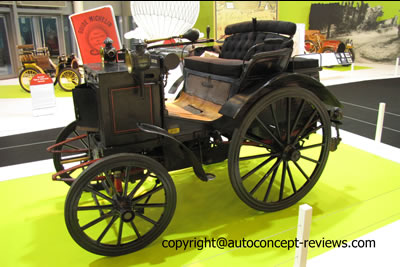 |
 |
| 1890-1896 Panhard & Levassor Type P2D |
2018 Renault EZ-Ultimo Autonomous Concept |
The success of this event will be the results of an exceptional exhition of historic automobiles all over the halls. We have tried here to provide you with an overview of historic cars exhibited at the Paris Motor Show. The Mondial Paris Motor Show was the occasion to see different technical properties like aluminium monocoque structure, hybrid propulsion system, or electric car batteries. when possible we tried to share it with you in this report.
Electric Drive -Hydrogen Fuel Cell Propulsion
 |
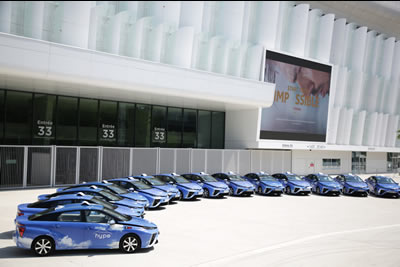 |
| World Premiere Mercedes Benz EQC First Full Electric SUV |
25 Hydrogen Fuel Cell Toyota Mirai delivered to Paris HYPE Taxi |
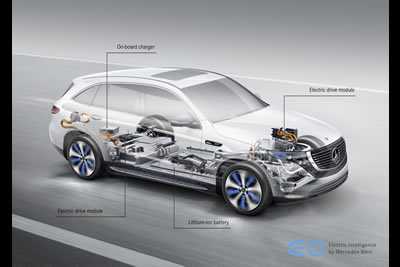 |
 |
Electric vehicles remain the main exhibit topic , in particular,with the world premiere of the first full electric automobiles proposed by Mercedes Benz EQ or Audi e-Tron. The electric drive is now widely completed with driverless solutions.
The Japanese Automotive Engineering Company ASPARK exhibited its Limited Edition OWL Premium Electric sports car proposed at 3,1 million Euros for 50 units. The standing start 0-100 km/h is announced for 1,99 seconds with road legal tires. The top speed is claimed at 280 km/h while the drive range is one charge is specified for 300 km. Four motors, one per wheel, combine a total power of 860 kW(1.150 bhp) for a dry weight of 1460 kg.
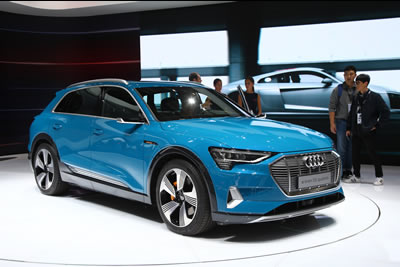 |
 |
| Audi e-Tron First Full Electric SUV |
Aspark Owl Electric Sports Car - 3,1 million Euros |
The electric drive is represented by automobiles with larger battery for longer range like the BMW i3 or the hydrogen fuel cell solution illustrated in particular with Paris HYPE taxis operating with Fuel Cell Toyota Mirai or Hyundai i35; 25 Toyota Mirai have just been delivered to HYPE taxi a few days before the opening of the show. Hyundai exhibit its Nexo Model while Plastic Omnium announces a new program oriented toward fuel cells at a cost of 5.000 Euros altogether with the production of hydrogen storage tanks. A prototype of electric Renault Kangoo is displayed with hydrogen fuel cell range extender capable of a further 170 km for 1,7 kg hydrogen.
In France according to avere.org there are presently 150.000 electric vehicles on the road and in 2016 sales for electric vehicles resulted in 27.307 new registration, the largest market result in Europe (total 2016 in Europe is 102.625 vehicles). According to Quartz qz.com, China registered as many as 352,000 new electric vehicles (EV) in 2016, compared to only 159,000 cars registered in the US during the same time period (more than half of which were in California).
Driverless Shuttles
In 1956, General Motors introduced the Firebird II with gas turbine propulsion and Safety Autoway automatic control on a dedicated lane of the highway. Entering into radio and television communication with e nearby Control Tower, you indicate that you wish to switch to automatic pilot. The Tower directs you to move into the middle lane, where your car stradles a metallic conductor which emits electronic signals to your car. These signals, of different wavelengths, are picked up by probes at the front of your car and fed into motors which control steering, speed and braking.
When you are "tuned in" with the system, you relinquish control and your car is automatically channelled into the high-speed lane-still riding over a signal emitting control band.
From here on, your car is "driven" by an electronic brain which has been fed all pertinent information, including your destination. All cars in the high-speed lane travel at a constant speed, at the proper distance from each other and without passing. In the case of an emergency all cars are automatically braked and slowed down. In extreme cases, cars can be automatically directed to slower speed lanes.
Not only do you relax and enjoy your journey, but you are safe as modern science can make you. For, while human beings can err in judgment, the electronic brain is completely foolproof. And the description goes on, the steering wheel can be recessed in the dashboard when the car is in "auto pilot". That was in 1956 and just one story by one major car manufacturer at the time. It was more than sixty years ago.
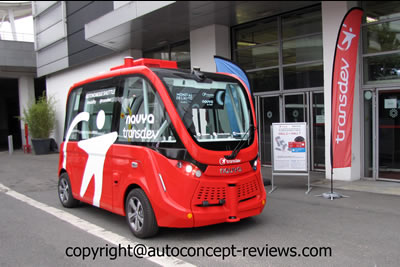 |
 |
| Transdev Autonomous Shuttle operating on Mondial site |
Altran Autonomous Transport Project |
Nowadays, for several years several companies are proposing research and development for autonomous automobile with artificial intelligence and no driver action required.
The Navya and Transdev autonomous shuttles are operating in the area of the Mondial exhibit. Several autonomous vehicle solution are proposed but it is mainly oriented with people or parcel transportation in closed areas. Navya has sold today some 80 autonomous shuttles for commuting in France, Japan, Australia, Switzerland or Sweden. Transdev exhibited its electric shuttle installed today for shared commuting autonomous services in urban, suburban or private places in France and Florida (USA). Renault introduced several projects of autonomous shuttle as concepts. Altran presented a completed project of urban transportation operated around the smart phone application secured by facial recognition and a small autonomous two seat shuttle. AW Technologies introduced technologies for autonomous transportation operated with smart phone applications. And that is just a few example. The main argument for autonomous driving today is again safety; autonomous vehicles avoid human error accident and fatalities. Is it dangerous to climb aboard a bus operated by a qualified driver?
Research and development certainly allow to propose new driving assistance and improve safety. Premium automobile are gradually being equipped with new features that hopefully shall be extended to other cars.
Concept Cars
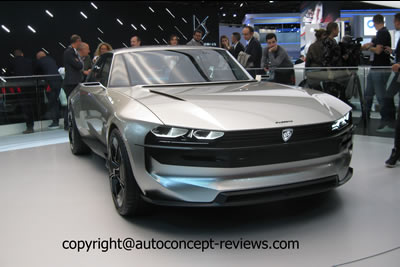 |
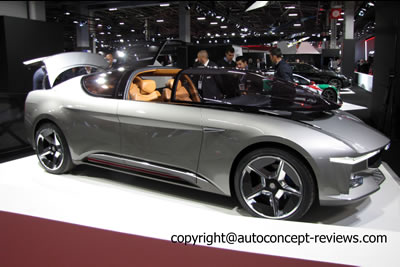 |
| Peugeot E-Legend Concept |
GFG Sibylla Concept by Giugiaro |
Concept cars are always exceptional exhibits in a Motor Show as it is the only place you can see them. Mercedes Benz, Smart, Audi, Renault, Peugeot, DS were the major providers of such design studies. Giugiaro GFC Style brought its Sibylla GG80 Electric Concept Vehicles already introduced at 2018 Geneva Motor Show. This concept marks Giorgetto Giugiaro's 80th birthday; this four-door luxury sedan is a celebration of a lifetime dedicated to iconic automotive design.
The Peugeot E-Legend Electric Concept is the nearest production reality model proposed while other exhibits are more free style automobile interpretations.
Exotic and Exclusive Automobiles
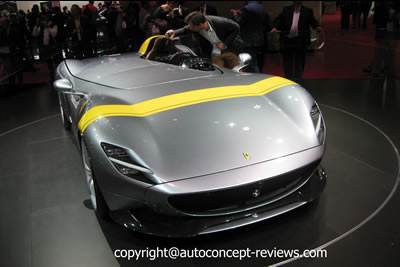 |
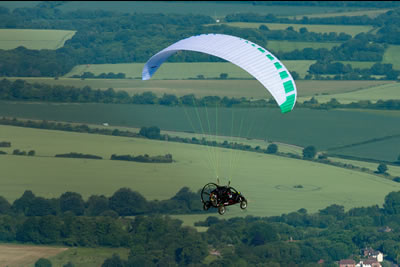 |
| Ferrari Monza SP1- first ICONA brand model |
Vaylon Pegase Flying Buggy |
Mondial Paris Motor Show was the occasion to admire exclusive automobiles that can seldom be seen on the public roads. The majority of such automobiles have already been introduced to potential customers in Exhibits like Pebble Beach Concours d'Elegance. This year, a Mondial Limited allowed showing several exotic automobiles where manufacturer's specific exhibit has not been prepared. It was the case for Lamborghini showing the last Aventador SVJ and several Huracan including GT3 racing version.
Ferrari introduced the Monza SP1 and SP2 that are the first models of a new ICONA exclusive brand.
We can also mention Vaylon and its Flying Buggy Pegase designed with the French Special Forces. The Pegase is equiped with two specific engines and can easily pass from flying mode to cross country or road mode. The prototype did cross the Channel between France and England during 2017.
-
-
-
-
-
1. 120 Years Automobile History
|
| |
1. 1890-1896 Panhard & Levassor Type P2D |
The Panhard & Levassor Type P2D is considered the first large production automobile as 195 examples were built between 1890 and 1896. The car is propelled by a Daimler V2 engine from 921 to 1290 cc. producing from 2 to 3,75 horsepower.
The Panhard & Levassor in 1895 to the Paris Bordeaux inter city race that it won together with a Peugeot Type 3, completing 1.190 km in 48 h 47 min.
|
| |
2. 1894 Peugeot Type 5 |
The Peugeot Type 5 with two seats and a 3 horsepower 2 cylinder 565 cc engine connected to a four speed gearbox.
14 examples were built between 1893 and 1896. This Peugeot won the Paris Rouen race organized by Le Petit Journal daily newspaper. |
| |
| |
3. 1898 Renault Type A Voiturette |
In 1897, Louis Renault, at the age of 19, was working as technical draftsman at Delauney-Belleville. He was a passionate for mechanics and very much interested by the newly appearing automobile. He decided to build his own car in a small workshop he arranged at the back of the family property in Boulogne-Billancourt. When the car was completed, by Christmas 1898, he invited some friends for a first drive in Paris and they set, particular to climb the Rue Lepic near Montmartre. His friends were so impressed that they ordered a similar car for themselves. A few of them provided with down-payment and Louis Renault decided to create the Société Renault Frères and started small production of the Type A.
see related article Renault Type A Voiturette 1898 |
|
| |
4. 1898 Jenatzy Electric Jamais Contente |
Jenatzy “ Jamais Contente” 1899 –this vehicle that established a record top speed of 105,879 kph. For the first time ever an automobile could go faster than 100 kph. Camille Jenatzy developed this special electric vehicle and drove it to the record top speed as a promotion for is Company “La Compagnie Internationale des Transports Automobiles” (International Automobile Transportation Company) that operated electric taxis in Paris.
related article 1898 Jenatzy Electric Jamais Contente |
|
| |
5. Renault Type K Paris Vienne Replica |
In the beginning of the 1900s racing competition between European cities was typical events; This Renault Type K brings the French car manufacturer a great victory by winning the Paris Vienne racing 1902 in all categories.
From the beginning the Renault brothers understood that competition was the best promotion tool for their company. They started with the city to city races in "voiturettes" (small cars) category, winning in several events
related article Renault Type K 1902 |
|
| |
6. 1905 Serpollet Type L Steam engine Double Phaeton |
Leon Serpollet founded Serpollet Freres et Cie and was a pioneer in steam engine propelled automobile. The Steam propelled car was successful till World War I and even gained the speed record with 15 km/h above Jenatzy Electric Jamais Contente. The record bearing car was called Gardner Serpollet "Eastern Egg" and it was April 13th 1902 when Leon Serpollet drove the car at 120,8 km/h at Nice on the "Promenade des Anglais". |
|
| |
7. 1922 Renault 40 CV Type JV Torpedo |
The Renault 40 CV with 9121 cc six cylinder engine can reach 130 km/h for a 2600 kg weight. The Renault 40 CV has been considered as the Premium Renault for the first quarter of the Twentiest century. The Type JV was introduced at 1922 Paris Auto Show. 148 Type JV shall be produced. Related article Renault 40CV NM Type JY Skiff 1923 |
|
| |
8. 1924 Peugeot Type 174 Coach Labourdette |
Louis Dufresne has worked with Panhard & Levassor, Citroen and Voisin before joining Peugeot where he introduced the valve-less Knight engine. The Type 174 is propelled by a 3873 cc four cylinder engine producing 75 HP and allowing a top speed of 100 km/h for a total weight of 2000 Kg. |
|
| |
9. 1926 Panhard & Levassor Record Breaker
|
During 1920 and 1930 many major car manufacturers competed for speed record breaking in view of promoting their Company. This Panhard & Levassor development was started in 1926 7940 cc six cylinder engine producing 290 hp. Top speed is announced at 220 km/h for a weight of 1200 kg. George Eyston established a new record on the Monthlery track on February 4th 1934 driving a specially prepared 290 hp Panhard & Levassor 35 CV and covering 214,044 km in 60 minutes. |
|
|
10. 1927 Hispano Suiza H6B Coupé Chauffeur by Letourneur & Marchand |
.The Model H6 was introduced by Hispano Suiza at the 1919 Paris Motor Show. The H6 is propelled by a 6.597 cc six cylinder engine producing 120 hp and allowing a top speed of 140 km/h. This particular automobile appeared in the 1989 film "La Vie et Rien d'autre" with Philippe Noiret and Sabine Azéma. |
|
|
11. 1927 Renault Type PR Autocar
|
Louis Renault was interested in autocar and autobus as he introduced his first model in 1909 that was delivered to Compagnie Generale des Omnibus. In 1925 specific autocar were developed for transporting people in mountain roads where train could not reach. This autocar is propelled by a four cylinder engine and allows transporting 10 passengers at 65 km/h. This type of autocar were often used in complement with the train for local shuttle of passengers. |
|
| |
12. 1929 Supercharged Bentley 4,5 Litre
|
This example of Bentley is racing works team N°2 car of Tim Birkin- registered UU5872 Chassis HB3403 and was rebodied in four seats open tourer by Vanden Plas in 1930.
It is propelled by 4.398 cc supercharged four cylinder producing 240 hp. Top speed is claimed at 200 km/h (125 mph). This racing car was used in Le Mans 24 Hours endurance race to force Rudolph Caracciola's Mercedes Benz SSK out of the race allowing the other two Bentley to complete a successful finish. This car comes from Bentley Heritage Collection. |
|
| |
13. 1930 Ford Model A Cabriolet
|
| This Ford Model A is propelled by 3.300 cc four cylinder producing 40 hp. Top speed is announced for 100 km/h. In 1937, Guy de Larigaudie and Roger Drapier completed a long journey through sixteen countries including Turkey, Syria, Palestine, Irak, Iran, Afghanistan, India, Birmany while crossing Himalaya. The journey completed 20.000 km and started from Holland |
|
| |
14. 1932 Bugatti Type 55
|
The Bugatti Type 55 was produced in 38 examples. The Type 55 was propelled by a supêrcharged 2.300 cc eight cylinder producing 160 hp and allowing a top speed of 185 km/h. The Bugatti Type 55 was deigned by Jean Bugatti who completed a 485 km journey in 3h 47 min that is at average speed of 120 km/h. |
|
| |
15. 1934 Renault Nervasport
|
| |
|
| |
16. 1935 Citroen Rosamie 7UB called "Croix du Sud 2004" in memory of Mermoz |
The car is propelled by a four cylinder engine producing 40 hp. With two fuel tanks the car is capable of 60 km/h and Claude Berton completed a long journey in 2004 in memory of adventurers like Mermoz. |
|
| |
17. 1956 Gas Turbine propelled Renault Etoile Filante
|
After World War 2, as the aeronautical industry boomed, it was only natural to attempt to carry aviation technology over to the automobile, a trend epitomized by the Renault Etoile Filante.
After 1945, turbine specialist Turbomeca sought to draw public attention to the use of gas turbines. Won over by the idea, Renault accordingly launched the development of an experimental car powered by a 270 hp powerplant - the tubular-framed, stratified polyester bodied Etoile Filante.
On September 5th 1956, the whine of its gas turbine echoed over Bonneville Salt Flats in the United States. Instants later, a new world record for turbine powered car was established: an average of 306,9 kph over one kilometre and 308,9 kph over five kilometres. related article Renault Etoile Filante 1956 |
| |
| |
18. 1956 Renault 4 CV
|
The Renault 4 CV was produced at more than 1.100.000 examples between 1946 and 1961. It was propelled by a rear positioned 747 cc four cylinder engine producing 26 hp. Maximum speed was announced at 100 km/h. The Renault 4 CV is the first Renault to be sold in more than one million units. It was propelled by a rear mounted 760 cc four cylinder engine in overhang position and three speed gearbox. The car could carry four occupants and claimed top speed was 90 kph. The weight was 560 kg for an overall lenght of 3.60 meter and 1.43 meter width. |
|
| |
19. 1957 Maserati 250F Formula One
|
The Maserati 250F is considered by many to be the most successful and most beautiful Grand Prix car in history. The Maserati 250F was planned after a new formula had been announced for the 1954 season. Famous engineer Gioacchino Colombo, who had been responsible for the invincible Alfa Romeo 158 and the very successful Maserati A6GCS sports car, added Valerio Colotti to his team and set out to develop the 250F, based on its ancestor the Maserati A6GCM. Featuring a tubular space frame, double wishbone front suspension, the gearbox mounted in the unit with the De Dion rear axle, the twin-plug engine run on methanol and a streamlined body designed by Fantuzzi, the 250F proved to be instantly competitive and perfectly balanced.
related article 1957 Maserati 250 F Lightweight |
|
| |
20. 1958 Cadillac Coupe de Ville Carrera Panamericana
|
The Carrera Panamericana race was first organized in 1950 in order to inaugurate the new 3.373 km mexican road joined the north to the south of the country. The specially prepared Cadillac exhibited here was propelled by a V8 producing 325 hp and allowing the car to reach 180 km/h. |
|
| |
21. 1958 Porsche 356A 1600 Sport Speedster
|
Exhibit Porsche Museum |
|
| |
22. 1963 Lotus 33 Formula One racing car |
| The Lotus 25, is the first monocoque Formula One racing car and the Lotus 33 introduced at the end of the season allowed Lotus to win its first Formula One Championship with Jim Clark at the wheel. The Lotus 33 is propelled by a Coventry Climax FWHV 1495 cc V8 producing 210 hp at 10.500 rpm with fuel injection. The car weighted 600 kg and the top speed is announced at 260 km/h. |
|
23. 1964 Willys Interlagos Berlinetta -made in Brazil |
Considering stringent import duties in Brazil, Renault and Willys with local manufacturing facilities invited Jean Rédélé to allow local production of the Alpine A110. The car was called Interlagos that is the name of Sao Paulo racing circuit. The Car was made at Willys facilicy with local Renault Dauphine based power unit. The 845 cc four cylinder engine produced 40 hp and was combined with a four speed gearbox . The car weighed 550 kg and the body was made of plastic composite with molds provided from France. Several cars were dedicated to competition and prepared in yellow and green that are the Brazilian racing colours. The legend tells that Emerson and Wilson Fittipaldi as well as Carlos Pace started their racing careers in this berlinetta.
related article Alpine A110 1962 to 1973 - Road and Racing version |
|
| |
24. 1965 Ferrari 250 LM
|
1964 was the time to develop a successor for the legendary Ferrari 250 GTO. Ferrari decided against resource-intensive advanced development and opted to fit a fixed roof to the existing open-top Type 250 P racing car for the Gran Turismo Class. The car was given the designation 250 LM and the body was developed by Pininfarina. The Ferrari 250 LM was used in the class of racing prototypes because the 100 units of this type necessary for homologation in the GT class could not be built by the end of 1965. On request, the Ferrari 250 lm could also be ordered in a roadworthy version and this made it the first series Ferrari to be powered by a centrally mounted engine. A total of 32 Ferrari 250 LM cars were manufactured. All were powered by the 3.3 litre V12 (3.285 cc.) developing approximately 320 hp, apart from the prototype with a three litre engine.
for further details and photos see Ferrari 250 LM Berlinetta 1964 by Pininfarina |
| |
| |
25. 1971 Citroen-Maserati SM |
The Citroen Maserati SM was produced at 12.920 examples between 1970 and 1975. It was propelled by a 2.670 cc V6 producing 170 hp. The car was equiped with hydro-pneumatic independant suspension at all wheel. The claimed top speed is 220 km/h. |
|
| |
26. 1972 Alpine Renault A310 |
Following the success of the Alpine Renault A 110, Jean Rédélé started the development of a 2+2 berlinetta Grand Touring car capable of competing with foreign famous GT cars. The Alpine Renault A310 was produced between 1971 and 1976 at 2.340 examples either with carburettor or with fuel injection. The A310 was propelled by a 1605cc four cylinder originated from the Renault R12 Gordini and combined with a five speed gearbox and producing 127 hp. The maximum speed was announced at 215 km/h. |
|
| |
27. 1972 BMW 3.0 CSi Coupé |
The BMW E9 was introduced on the market in 1968 with a 2800 cc six cylinder producing 170 hp and was replacing the BMW 2000 C/CS. In 1971 BMW replaces the 2800 CS by the 3.0 CS equiped with a 3.000 cc six cylinder producing 180 hp with carburettor or 200 hp with fuel injection. The claimed top speed for the BMW 3.0 CS fuel injected is 220 km/h |
|
28. 1972 Renault Torino - made in Argentina |
Argentina was developing its own industry with local manufacturing of foreign automobile companies. The American Kaiser Company had a joint operation with Renault under Industrias Kaiser Argentina (IKA) and produced locally Kaiser Rambler as well as Renault Dauphine in 1959 or Renault 6 and Renault 12 later on . The Argentina Government was looking for a 100% national automobile and that is how IKA created the local Renault Torino with 3.800 cc six cylinder engine producing 155 or 176 hp. The car proposed in sedan or coupe version was produced until 1982. It was capable of a top speed of 175 km/h. It weighed 1.070 kg. |
|
| |
29. 1978 Renault Alpine A442B Le Mans 24 Hours winner |
The 46th Le Mans 24 Hours saw the black and yellow team to victory, when the Alpine Renault-Elf #2 won one of the world's most prestigious events. Driven by Jean-Pierre Jaussaud - Didier Pironi, the car clocked up more than 5,000 km at over 210 km/h on average.
The Renault V6 engine had proved its worth since its launch in 1973. In that year it claimed its first victory as a sports prototype, followed by five others in 1974. In 1976 and 1977, the same engine was European Formula Two Champion twice in a row with Jean-Pierre Jabouille (Martini-Elf) and René Arnoux (Elf-Switzerland).
In 1975, it was boosted by a turbocharger, a technique patented by Louis Renault back in 1902, raising its power from an original 285 bhp to 500 bhp.
for further details and photos see Renault Alpine A442 V6 Gordini - Victory in Le Mans 24 Hours 1978 |
|
| |
30. 1987 1988 Porsche 959 |
At the 1983 IAA Frankfurt Motor Show, Porsche unveiled a Concept car with the designation "Group B". Introduced in 1982, the Group B was defined under FIA racing rules as competition vehicles in sportscar racing and rallyes regulated by the Federation Internationale de l'Automobile. The Group B regulations resulted in some of the most powerful and quickest machines for official racing events. It was a replacement for Group 4 dedicated to modified grand touring and Group 5 for touring prototypes
for further details and photos see Porsche 959 1987-1988 |
|
| |
31. 1996-1998 Porsche 911 GT1 -Street version |
In the mid-1990s, GT cars began to play an increasing important role in the motor racing sport. Porsche responded by applying an advanced, hi-tech racing concept to the design of the 911 GT1, which made its racing debut at the 64th Grand Prix of Endurance in Le Mans in 1996. The new dimension in sports car construction consisted in the first 'Eleven' being fitted with a mid-engine, for the six cylinder power unit was, for the very first time, moved to the middle, which provided balanced axle load distribution and also offered aerodynamic advantages. Another innovation was the switch from an air to a water cooling system, which reduced both thermal load and fuel consumption. two overhead camshafts per cylinder bank and four valves per cylinder were a standard feature of this high performance engine. The debut of the success. Although Reinhold Joest's custom-built Porsche won the race, the two Porsche 911 GT1s finished hot on its heels in second and third positions. Two years later, in 1998, the Porsche GT1 won against the toughest competition in a remarkable one-two finish at Le Mans.
for further details and photos see Porsche 911 GT1 Racing Coupé 1996-1998 |
|
| |
32. 2003-2006 Porsche Carrera GT |
Porsche introduced in 2003 a supercar to respond to market opportunity; Carbon fiber structure, 10 cylinder 5,7 liter with 605 cv at 8.000 rpm, ceramic disc brakes are part of the proposal. Production is limited to 1500 units. see Porsche Carrera GT 2003 |
|
| |
33. 2013 Porsche Plug-in Hybrid 918 Spyder |
Stuttgart, Germany, September 2013. The technologically pioneering Porsche 918 Spyder is celebrating its debut at this year’s International Motor Show (IAA) in Frankfurt. The super sportscar with plug-in hybrid drive marks the beginning of a new era for sportscar manufacturing. Never before has a super sportscar designed for everyday use offered such an impressive dynamic performance combined with the fuel consumption of a compact car. In setting this technological benchmark, the Porsche 918 Spyder is taking on a pioneering role similar to that of the 911 when it was unveiled at the IAA fifty years ago. see Porsche Plug-in Hybrid 918 Spyder 2013 |
|
| |
34. 2017 Peugeot Instinct Plug-in-hybrid Autonomous Concept |
PEUGEOT has revealed a glimpse into the future of mobility with its INSTINCT concept, a unique Shooting Brake which offers the option of fully autonomous driving.
Unveiled in Spain, the PEUGEOT INSTINCT Concept is powered by a PHEV powertrain offering 300 Ps. The car features both ‘Drive’ and ‘Autonomous’ modes, affording the driver the choice between an engaging drive and the convenience of a fully autonomous vehicle
. see Peugeot Instinct Plug-in-hybrid Autonomous Concept 2017 |
|
| |
35. 2017 Renault Symbioz Electric Autonomous Concept |
“No longer can we think of car design in isolation from the ecosystem surrounding us, or from the evolution of major changes like electric energy use, connected and autonomous drive technologies that influence our lives as we move from place to place. This is truly a unique project that allowed us to work with our planners, designers & engineers, academics & architects, startups and sociologues to explore new boundaries in customer experience, technology and energy use and design harmony to form a complete experience.”
Laurens van den Acker – Senior Vice President, Corporate Design
The SYMBIOZ concept showcases Renault’s vision of the car of the future and its role in our lives inside and outside the car. It comprises a car, a demo car and a home. SYMBIOZ comes under the ‘Wisdom’ petal of Renault’s lifecycle-based design strategy, suggesting maturity.
see Renault Symbioz Electric Autonomous Concept 2017 |
| |
| |
| |
2.Electric Drive and Hydrogen Fuel Cell Propulsion |
| |
1. Mercedes Benz EQC - first Full Electric EQ Mercedes Benz
|
The Mercedes Benz EQC is the first model under the product and technology brand EQ
- EQ stands for "Electric Intelligence"
- It is derived from the Mercedes-Benz brand values of "Emotion" and "Intelligence"
- The EQC (combined power consumption: 22.2 kWh/100 km; combined CO2 emissions: 0 g/km, provisional figures)1 is part of a growing family of all-electric vehicles from Mercedes-Benz
- Conceived to meet all the requirements for a battery-electric drive system
- Convincing in the sum of its attributes with respect to comfort, quality and operating range
- An electric range of more than 450 km according to NEDC (provisional figure)
related article Mercedes-Benz EQ Pure Electric SUV Coupé Concept 2016 |
|
| |
2. AUDI e-Tron - the first fully electric production Audi |
Fossil fuel really is ancient history for this car – today marks the start of a new era for Audi as the e-tron, its first ever fully electric model, makes its world debut in San Francisco. The full-size SUV derives high performance and impressive agility from powerful front and rear electric motors energised by a large high-voltage battery – in combination these facilitate sub-six-second acceleration potential and a driving range of at least 248 miles (399 km) in the WLTP driving cycle, and ensure delivery with trademark Audi composure by operating as an electric all-wheel drive system. Complemented by a comprehensive range of charging options for home and on the move, and by the latest in-car communication, entertainment and assistance technologies, the Audi e-tron is perfectly placed to make the transition to fully electric driving as seamless as possible for devotees of the four rings.
Standing 4,901 millimetres long, 1,935 millimetres wide and 1,616 millimetres high, the new Audi e-tron offers the space and comfort of one of the brand’s typical full-size models. With a wheelbase of 2,928 millimetres, it has ample space for five occupants, and its total luggage capacity of 660 litres ensures that it can also comfortably accommodate their luggage.
Powerful performance on any terrain: drive and dynamic handling system
Efficiency, performance and tranquility – the Audi e-tron exemplifies the driving experience of a new era. Two electric motors drive the electric SUV powerfully, free of emissions, and almost silently, with a system output of up to 300 kW and 664 Nm (489.7 lb-ft) of torque. Peak torque is available within fractions of a second, enabling the e-tron to complete the standard sprint in 5.7 seconds. Top speed is an electronically-limited 124mph
|
|
| |
3. TESLA Model 3
|
The Tesla Model 3 is a smaller, simpler and a more affordable electric car compared to the current Tesla Model S. Designed and built as the world’s first mass-market electric vehicle, it is a critical step in Tesla’s mission to accelerate the world’s transition to sustainable energy.
Like every Tesla vehicle, Model 3 combines range, performance, safety and technology. Intelligent design maximizes interior space to comfortably fit five adults and all of their gear. The high-efficiency powertrain provides zero to 100 km/h acceleration in as little as 3.7 seconds.
Standard Battery - Range: 346 kilometers (EPA estimated)
Long Range Battery - Range: 499 kilometers (EPA)
Rear-Wheel Drive
- 0-100 km/h: 5.4 seconds
- Top speed: 225 km/h
All-Wheel Drive
- 0-100 km/h: 4.8 seconds
- Top speed: 233 km/h
|
|
| |
4.
Jaguar I-Pace
|
- New all-electric I-PACE places Jaguar at the forefront of the electric vehicle revolution
- Designed from the outset as an electric vehicle (EV), the I-PACE offers bold aero-efficient design, and interior space for five adults and luggage
- Electrifying all-wheel drive performance from twin Jaguar-designed motors with a combined 400PS and 696Nm delivering 0-60mph in 4.5s
- 90kWh Lithium-ion battery delivers up to 298 mile range1, with EV navigation to ensure range-optimised routing
- Bespoke EV aluminium architecture delivers Jaguar’s most rigid body structure with 50:50 weight distribution
|
|
| |
5.
Hyundai Kona Electric
|
- With the launch of the All-New Kona Electric, Hyundai Motor is offering the first fully-electric subcompact SUV on the European market.
- The new model in Hyundai’s eco line-up is available with two different powertrain versions, offering an outstanding range of up to 300 miles. .
- The first fully-electric subcompact SUV features a unique exterior design with closed grille and a dedicated centre console in the interior for intuitive operation of the shift-by-wire gear control.
The All-New Kona Electric features two different powertrain versions, offering customers one of the most powerful electric motors. The long-range battery version provides driving range of up to 292 miles*, delivering a maximum output of 204 PS (150 kW). With a battery capacity of 39,2 kWh, the basic version drives up to * on a single charge with the motor delivering 135PS (99 kW). With 395 Nm of immediate torque and an acceleration of 7.6 seconds from 0 to 100 km/h, the All-New Kona Electric provides a fun-to-drive experience.
With a battery capacity of 39,2 kWh, the basic version drives you up to 186 miles on a single charge with the motor delivering 99 kW and an energy consumption as low as 14.8 kWh/100 km (internal target under WLTP regulations).
Both powertrain versions deliver 395 Nm of immediate torque, offering the driver of Kona Electric great fun-to-drive, having the full power available from the first second, providing a maximum speed of 167 km/h. |
|
| |
6. Aspark Owl Electric Hypercar |
The Japanese Automotive Engineering Company ASPARK exhibited its Limited Edition OWL Premium Electric sports car proposed at 3,1 million Euros for 50 units. The standing start 0-100 km/h is announced for 1,99 seconds with road legal tires. The top speed is claimed at 280 km/h while the drive range is one charge is specified for 300 km. Four motors, one per wheel, combine a total power of 860 kW(1.150 bhp) for a dry weight of 1460 kg. |
|
| |
7.
Hyundai NEXO Hydrogen Fuel Cell Second Generation Automobile
|
“Hydrogen energy is the key to building a more sustainable society. Hyundai Motor Company has already taken a lead in hydrogen technology with the introduction of the ix35 Fuel Cell,” said Dr. Woong-chul Yang, Vice Chairman, Hyundai Motor Company. “I am so proud to introduce to you our second-generation Fuel Cell Electric Vehicle which is a culmination of our cutting-edge technologies.”
NEXO is Hyundai’s second-generation of commercialised fuel cell electric vehicle that will be available in select markets around the world starting in early 2018. Improving upon the acclaimed ix35 FCEV, the NEXO has an estimated driving range of 500 miles (NEDC) – 134 miles more than its predecessor. Acceleration and power have increased to improve the overall performance.
Designed to handle extreme temperature and environments, the NEXO testing has proven that the vehicle is capable of starting after being subject to overnight temperatures of -20 degrees Fahrenheit. NEXO boasts cold start capability within 30 seconds which is an industry-leading achievement and the fuel cell system warms up faster for maximum performance. The NEXO also has excellent cooling performance on steep grades with temperatures exceeding 120 degree Fahrenheit.
Related article Hyundai i 35 Hydrogen Fuel Cell 2013
Overall Summary
|
NEXO |
Ix35 Fuel Cell |
Dimensions |
Length(mm) |
4671 |
4409 |
Width(mm.) |
1859 |
1821 |
Height(mm.) |
1630 |
1656 |
Wheelbase(mm.) |
2789 |
2639 |
Power |
135kW
Fuel Cell : 95kW
Battery :40kW |
124kW
Fuel Cell : 100kW
Battery : 24kW |
Motor |
120kW
291 lb.-ft. of torque |
100kW
221 lb.-ft. of torque |
0 to 60 mph |
9.5 seconds |
12.5 seconds |
Range |
500 estimated NEDC |
369 miles |
|
|
| |
8. Citroen C5 Aircross Plug in SUV |
World premiere: New Citroën C5 Aircross SUV Hybrid Concept. This concept foreshadows the rechargeable Hybrid version of New C5 Aircross SUV, Citroën's first PHEV model in the Core Model Strategy which will lead to 80% of the range having an electric option by 2023 and 100% by 2025. This model benefits from greater comfort due to its versatility and its Zero Emission mode |
|
| |
9.
Plastic Omnium Hydrogen Fuel Cell Project
|
| Plastic Omnium announced a project for development of hydrogen fuel cell propulsion system that include not only the production of hydrogen storage tank but also fuel cell units with a target of reaching a 5.000 Euros unit for large diffusion of the technology. Plastic Omnium exhibited a prototype of Electric Renault Kangoo with hydrogen fuel cell range extender where 1.7 kg hydrogen allow an additional operating range of 170 km. |
|
| |
3. Driverless Shuttles |
| |
1 - ALTRAN autonomous shuttle |
ALTRAN is working on development of Individual or Public Transportation autonomous shuttles. The Individual Transportation exhibited at the Mondial operates with smart phone application and is secured by facial recognition. Some parcels can also be delivered by the same system and the lockers can be opened on arrival once again by facial recognition on a smart phone application. |
|
| |
| |
2 - Navya autonomous shuttle |
| The NAVYA autonomous shuttle was in operation on the 2018 Mondial site. NAVYA has already sold 79 autonomous shuttles around the world for cities and private sites. Let us just mention a few examples: MCITY Michigan, USA, POSTBUS Sion, Switzerland, Trapeze Neuhausen Switzerland, Paris La Defense France, Chalmers University Göteborg Sweden, NAVLY Lyon France, WKCDA Hong Kong China, SB Drive Tokyo Japan, TEPCO Fukushima Japan, LA TROBE University Melbourne Australia or NANYANG Technological University Singapore. |
|
| |
3 - Transdev autonomous shuttle |
Transdev was operating driverless shuttles on the site or the 2018 Mondial. Transdev is specialized in Shared Autonomous Transport Services and operates in Rouen France, Saclay France, Verdun France as well as Babcock Ranch Florida USA. |
|
| |
| |
|
| |
1.
Mercedes Benz Vision EQ Silver Arrow Concept |
The Vision EQ Silver Arrow is conceived as an electric vehicle. This soundless Silver Arrow has an output of 550 kW (750 hp). The thin rechargeable battery in the underbody has a useable capacity of approx. 80 kWh and enables a calculated range of over 400 km according to the WLTP. Side air vents help to cool the battery.
The one-seater vehicle is also an homage to the successful record-breaking W 125 car from 1937. The paintwork in alubeam silver is reminiscent of the historic Silver Arrows which, for weight reasons, did not have a white paint layer. The interior is dominated by traditional, high-quality materials such as genuine leather, polished aluminium and solid walnut. The digital cockpit, meanwhile, points directly into the future: It includes a curved panoramic screen with back projection, as well as a touchscreen integrated into the steering wheel.
"Over 80 years ago, the historic Silver Arrows demonstrated that Mercedes-Benz was a pioneer when it came to speed thanks, among other things, to their streamlined shape," says Gorden Wagener, Chief Design Officer at Daimler AG. "The Vision EQ Silver Arrow draws on that legacy. Intended for acceleration and driving pleasure, it embodies progressive luxury and provides an insight into the future of our design. As a result, the show car drives the design idiom of our new EQ product and technology brand to the top."
related article Mercedes Vision EQ Silver Arrow 2018 |
|
| |
2. Peugeot E-Legend Concept |
PEUGEOT unveil its vision for the future of mobility at 2018 ’s Paris Motor Show – a 100% autonomous, electric and connected vehicle called the e-LEGEND CONCEPT.
Adopting a realistic and yet radically modern template, the e-LEGEND CONCEPT still carries the DNA of the PEUGEOT brand and exudes elegance and rich heritage. The PEUGEOT e-LEGEND CONCEPT is powered by a 100% electric power train, with the 100 kWh batteries reaching 800 Nm torque and 340 Kw power, distributed to the four-wheel drive. This level of performance makes it possible to travel 0/100 km/h in less than 4s and reach a maximum speed of 220Km/h. The range is 600 km according to the WLTP protocol, of which 500 km are accessible in 25 minutes thanks to a fast recharge. PEUGEOT e-LEGEND CONCEPT cultivates the zero technological constraint mind-set by offering induction charging.
Related Article Peugeot E-Legend Autonomous Electric Concept 2018 |
|
| |
3. Renault EZ ULTIMO, EZ GO and EZ PRO Autonomous Vehicles Design Studies |
With EZ-ULTIMO, Renault completes its 2018 trilogy of robot-vehicle concepts that explore the shared mobility of tomorrow. Functional or emotional, for the transport of goods or people, EZ-GO, EZ-PRO and EZ-ULTIMO say a lot about the future vision of Groupe Renault.
In 2018, Groupe Renault rhymed with shared mobility! For the first time, a car manufacturer offers a complete and complementary family of robot-vehicles. These three concepts illustrate an overall vision.
It is based on the four pillars of Groupe Renault's Drive the Future (2017-2022) strategic plan: electric, connected, autonomous and shared.
EZ-GO, EZ-PRO and EZ-ULTIMO offer a mobility experience that has been designed for everybody and can be accessed by as many as possible. A customizable and fully connected experience that plugs into the ecosystem of the intelligent cities that are developing, and has a positive impact on them. They cover different uses, as explained by Laurens Van den Acker, Director of Design and Thierry Bolloré, Chief Operating Officer of Groupe Renault.
"A trip, it goes beyond a mere destination. With EZ-ULTIMO, you travel through the robot-vehicle and travel through the proposed content.” Laurens Van den Acker |
|
Functional, for shared day-to-day urban mobility with EZ-GO
"On-demand and shared mobility services are an important opportunity for Renault, especially in cities. EZ-GO offers a glimpse of what the future might look like.” Thierry Bolloré |
|
"EZ-PRO is both an opportunity for professionals and a service facilitator for all its users. t is based on the brand's DNA, which puts people at the heart of its solutions.” Laurens Van den Acker |
|
| |
4. DS X E-TENSE Concept -A dream for 2035
|
In today’s fast-morphing automobile industry, the men and women at DS Automobiles were tasked with bringing to life their dreams for the car of tomorrow while sharing their automobile passion, uncurbed by predetermined constraints.
The fruit of that passionate, unfettered journey is DS X E-TENSE.*
Their vision for 2035 is very different from the current, near-obsessional quest for characterless mobility. Instead, the designers at DS sought to blend the benefits of advanced technology with a large measure of poetic creativity. Their answer explores how customers who have no qualms about indulging themselves and how they might perceive the notion of a luxurious French style eighteen years hence, however diverse their needs.
The cockpit is accessed by an Elytre door that is trimmed with a carbon fibre/leather weave. Inevitably, the eyes are drawn to the pyramidal architecture of the single seat, which adapts perfectly to the driver’s build like the fitted seats seen in motor racing, while its reclined position helps to keep the car’s centre of gravity low.
DS X E-TENSE’s asymmetric architecture provides distinct ambiences left and right. Climb into the cocoon part of the interior via the gullwing door and the driver, alone or accompanied, becomes a passenger. This asymmetric layout frees up a different type of space underneath the clear glass canopy, with the passenger enclosed in a sensuous capsule, snug in a ventilated. An additional seat even makes it possible to travel three-up.
Located within the front wheels, the two motors selected as the source of the all-electric DS X E-TENSE’s power provide unrivalled response. For road use, peak power stands at 400kW (540 horsepower), a figure that rises to 1,000kW (1,360 horsepower) in ‘circuit’ mode which allows the driver to savour the exquisite performance of the suspension engineered by DS Performance, the technical team behind DS’s Formula E programme. The carbon fibre chassis sits on innovative springs and torsion bars, while traction, grip and deceleration is controlled by an advanced active system conceived to optimise performance, whatever the type of road surface. |
|
|
| |
5. Audi e-Tron GT Concept
|
Before the exhibition at Mondial Paris, the Audi e-Tron GT was presented at Pebble Beach Concours d'Elegance. For the first time, Audi has presented a design and technical concept car at Pebble Beach Automotive Week in Monterey, California. The all electric Audi PB18 e-tron presents a radical vision for the high-performance sports car of tomorrow. Broad and flat, visibly inspired by the wind tunnel and the race track, its very presence signals that it is destined to push boundaries. Its concept and exciting lines were created in the new Audi design studio in Malibu, California – where the brand’s design is consistently being updated for the future. The technical concept of the PB18 e-tron has benefitted from Audi's many years of winning the Le Mans racing series. The experts at Audi Sport GmbH, the high-performance subsidiary of Audi, were responsible for implementation. The abbreviated name “PB18 e-tron” refers both to the Pebble Beach venue for the premiere and to the technological DNA it shares with the successful LMP1 racing car Audi R18 e-tron.
Consistently focused concepts for use At first sight, the Audi PB18 e-tron shows its kinship with another spectacular concept car from the brand – the Audi Aicon from 2017. This holds true not only for characteristic design elements like the side windows that angle inwards and the extremely extended wheel arches. The two concept cars from 2017 and 2018 also share their electric drive with solid-state battery as energy storage.
Emotion without emissions: three electric motors and quattro drive The concept uses three powerful electric motors – one up front and two in the rear. The latter are centrally located between the steering knuckles, each directly driving one wheel via halfshafts. They deliver power output of up to 150 kW to the front axle and 350 kW to the rear – the Audi PB18 e-tron is a true quattro, of course. Maximum output is 500 kW, with boosting, the driver can temporarily mobilize up to 570 kW. The combined torque of up to 830 newton meters (612.2 lb-ft) allows acceleration from 0 to 100 km/h (62.1 mph) in scarcely more than 2 seconds – a speed that differs only marginally from that of a current LMP1 prototype.
related article Audi PB18 e-tron Electric Single Seat Concept at Pebble Beach Concours d'Elegance 2018 |
|
| |
6. GAC Everge Electric Concept
|
The Chinese GAC Motors introduced a full electric SUV Concept among its range of models propelled by internal combustion engine. |
|
| |
7.GFG Sibylla
|
Giugiaro GFC Style brought its Sibylla GG80 Electric Concept Vehicles already introduced at 2018 Geneva Motor Show. This concept marks Giorgetto Giugiaro's 80th birthday; this four-door luxury sedan is a celebration of a lifetime dedicated to iconic automotive design.
The GFG Sibylla GG80 is a smart electric sedan developed in collaboration with Envision Energy, a leader in smart energy management. The vehicle uses Envision’s EnOS™ energy IoT platform to integrate with its surrounding energy infrastructure, allowing the car to become intelligently integrated into the wider energy ecosystem. The design is functional and ergonomic, echoing the seamless integration of EnOS™.
A four-door luxury sedan, the car incorporates innovative solutions in terms of accessibility, functionality, and aesthetics. It revisits classic themes; it is elegant, with generous dimensions (over 5 metres long and 1.48 metres high). The choice of electric propulsion enhanced the interior space and allowed Giorgetto and Fabrizio Giugiaro to revolutionize accessibility and exploit this space by introducing rational, functional, ergonomic solutions both inside and outside of the vehicle.
An electric car with a 75 KWh battery can store as much electricity as an average European household consumes in a week. Integrating the car into the energy system means the car can be both an energy source and help contribute to stabilizing the energy grid, a critical link between energy supply and demand. With EnOS™, the car not only connects to a network of renewable energy assets, but also communicate and shares energy with other vehicles, homes and buildings, enabling clean, secure and affordable electricity in a flexible and smart future energy system.
The panoramic windscreen extend to the B pillar and cover the full front seats;it slides forward in order to allow entering or exiting the front seats. The Sibylla is defined to be able to run on the road with the windscreen forward. The rear windows are substituted by gull wing type panoramic side elements.
related article : Giugiaro GFG Style Sibylla GG80 2018 |
| |
| |
8. Hyundai Le Fil Rouge Design Study |
Before this exhibit at the Mondial, Hyundai Motor unveiled the ’Le Fil Rouge’ concept car at the 2018 Geneva International Motor Show, marking a new beginning for Hyundai design and providing a glimpse of its future design direction. As its name implies, ‘Le Fil Rouge’ (English translation: common thread) is a reflection of Hyundai’s belief that the brand’s past, present and future designs are all connected.
The exterior and interior are smoothly merged by the ‘Tube Architecture’, keeping the exterior’s sensuous and sporty character consistent inside the vehicle. The Tube Architecture’s principle is to create the same emotional value inside and outside the vehicle, while also allowing for a lightweight profile.
The interior design differentiates between the needs of both the driver and passengers. The front passenger seat maximises comfort even on long-distance trips with more ample leg room, while the driver’s seat is designed to add to the fun on driving with optimised ergonomics. A wrap-around architecture emphasises depth, creating a calm, spacious and comfortable travel environment for everyone in the car.
No technical details are available concerning propulsion technology. |
|
| |
9.Porsche Speedster Concept |
Stuttgart. The concept study, presented during the 70th birthday of the sports car manufacturer, will be produced as a limited special edition: Porsche has decided to start producing the purist Porsche 911 Speedster in the first half of 2019. Exactly 1,948 units of the open-top two-seater will be built. The number reminisces the Porsche 356 “Number 1” that received its operating license on June, 8 back in 1948. In Paris, Porsche presented this year’s second Speedster Concept study. Its Guards Red paintwork is a reference to the 1988 911 Speedster of the G-Model generation. The new cross-spoke 21-inch wheels in cross spoke and the black leather interior create a tasteful and sporty appearance. |
|
| |
10. SMART Forease Concept
|
Stuttgart/Paris. smart celebrates its 20 anniversary at the Paris Motor Show with a show car that interprets and embodies urban driving fun in a refreshing way. The smart forease is extroverted and offers an uncomplicated solution for urban mobility. Seated under the open sky, the driver is at the centre of the hustle and bustle of the city, in which, thanks to the electric drive, they can freely participate.
It also affords a preview of the electric future of the smart brand. smart is the first automotive brand with its sights set on a systematic switch from the combustion engine to the electric drive: since 2017, smart has been selling only electric vehicles in the USA, Canada and Norway. From 2020, it will be marketing only battery-electric cars in Europe, too. The rest of the World is due to follow soon after. The smart forease makes it clear that electric cars for use in the city will be anything but boring. |
| |
5. Exotic and Exclusive Automobiles |
1.
Ferrari 488 Pista Aperta
|
The Ferrari 488 Pista Aperta was introduced at Pebble Beach Concours d'Elegance and the Mondial was the first occasion for the public to have a look at the new 720 hp 3902cc twin-turbo V8 propelled roadster. For further details and photos see Ferrari 488 Pista Spider unveiled at Pebble Beach Concours 2018 |
| |
| |
2. Ferrari Monza SP1 and SP2
|
| The new Ferrari Monza SP1 and SP2 have been unveiled on occasion of the company’s Capital Market’s Day at the factory in Maranello. These limited-edition special-series cars are the first in a new segment called ‘Icona’ and draw inspiration from the most evocative Ferraris of the 1950s and feature the most advanced sports car technology available today. The two exclusive automobile have been exhibited at the Mondial Paris Motor Show. For further details and photos see The Ferrari Monza SP1 and SP2 are the first models in a new concept of limited-edition special series called ‘Icona’ |
| |
7. Lamborghini Aventador SVJ
|
The Lamborghini Aventador SVJ was introduced at Pebble Beach Concours d'Elegance before being exhibited at the Mondial Paris Motor Show. For further details and photos see Lamborghini Aventador SVJ and SVJ63- 770 hp 4 Wheel Drive 4 Wheel Steering 2018 |
| |
| |
8.
Ferrari 812 Superfast
|
The Ferrari 812 Superfast was introduced in 2017 and it was exhibited at the Mondial Paris Motor Show for the public to have the opportunity to have another look at this exclusive berlinetta. For further details and photos see Ferrari 812 Superfast 2017 |
|
| |
9.
Honda NSX and NSX GT3
|
| Honda has announced a range of enhancements for the 2019 NSX, which will make the ground-breaking hybrid supercar even more pleasurable to live with day-to-day, and even more exciting to drive on track.
The focus has been to enhance the exceptional dynamics of the car while maintaining its outstanding everyday usability. Honda has equipped the 2019 NSX with larger front and rear stabiliser bars, which increase stiffness by 26 percent at the front and 19 percent at the rear. The rear hubs and control-arm toe link bushings are also stiffer, further boosting responsiveness through the chassis.
Honda, in conjunction with JAS Motorsport, Honda Performance Development (HPD) and Mugen has introduced in 2017 the NSX GT3 for sale around the world for the 2018 season
Already a multiple-race winner in its inaugural season of IMSA WeatherTech SportsCar Championship competition in North America, the Honda NSX GT3 is eligible to race in more than two dozen FIA-sanctioned race events around the world, including:
- The Blancpain GT Series, Nurburgring 24 Hour race in Europe;
- The Pirelli World Challenge and IMSA SportsCar series in North America;
- The Blancpain GT Asia Series and GT Asia championship
- Super GT’s GT300 class in Japan
- The Australian GT Championship
- Intercontinental GT Challenge
The Honda NSX GT3 exhibited at the Mondial Paris Motor Show is the one that participated to the 2018 Spa Francorchamp 24 Hours endurance race.
related article Honda Acura NSX Supercar 2015 |
|
| |
10.Bugatti Chiron
|
The Bugatti Chiron was first introduced in 2016 with 1500 hp W16 engine and a top speed limited to 420 km/h. The Bugatti Chiron is intended for a production limited to 500 examples at base price of 2,4 Million Euros. For further details and photos see Bugatti Chiron 2016. |
|
| |
11. Audi R8 LMS GT3 2019
|
Audi Sport customer racing is presenting its fourth new model in just four years: Following the radically new second generation of the Audi R8 LMS (2015), the Audi RS 3 LMS TCR touring car (2016) and the Audi R8 LMS GT4 sports car (2017), the updated Audi R8 LMS GT3 has been unveiled at the Paris Motor Show in October 2018. The new evolution of the model that is successful in worldwide sprint and endurance racing is closely tailored to customers’ needs in terms of technology and price.
Bathurst, Daytona, Dubai, Laguna Seca, Nürburgring, Sepang, Spa: Ever since the Audi
R8 LMS made its debut in 2015, it has been entering its name in the winners’ lists of
the major endurance races. Worldwide championship titles, plus international
successes in the FIA GT World Cup and in the Intercontinental GT Challenge complete
the track record of a young winning car. So what could still be improved? “We’ve put
an even stronger focus on our large base of customers and their interests,” says Chris
Reinke, Head of Audi Sport customer racing. “The pre-design stage of the second
evolution of our current model generation was centered on many discussions with our
teams.” In addition to the pros who are successful with the race cars, amateur drivers
have been clinching victories and even class or overall titles in America, Asia,
Australia, and in New Zealand and Europe as well.
In the development project, Audi Sport concentrated on providing these customers
with even better support than before. Optimizations in the areas of aerodynamics and
cooling make for even greater consistency of handling performance in diverse fielding
applications. Durability of the power transmission elements was another focal area.
For the teams, the evolution package pays off both in terms of racing and economy:
Moderate modifications of the overall concept and the longer maintenance intervals
for the clutch and transmission stand for sensible investments that promise success
in racing and optimally support amateurs. Whether the teams already own a secondgeneration
Audi R8 LMS or buy a new model: the changes benefit everyone and are
suitable for retrofitting existing race cars as well.
Following the world debut in Paris, Audi Sport will deliver the first customer race cars
in November at a selling price of 398,000 euro (plus VAT). The evolution kit for
retrofitting older vehicle generations costs 28,000 euros (plus VAT). Following FIA
homologation, the race cars will be able to internationally battle for points, victories
and titles starting in January.
|
| |
12.Alpine A110
|
The entire A110 family was on display with the A110 Pure, two A110 Légendes and the A110 GT4. For further details and photos see Alpine A110 2017
|
| |
13.Toyota Supra GR Racing Concept
|
A compact, two-door car, the GR Supra Racing Concept has a pure front-engine/rear-wheel drive configuration and makes use of advanced lightweight materials in its construction.
Created by TOYOTA GAZOO Racing, the concept perfectly expresses the "fun to drive" quality that is intrinsic to Toyota's commitment to making ever-better cars. The large "90" race number on its doors is a historical reference to Supra's codename and a big visual clue to the fact that this concept heralds Supra's return in a fifth generation.
Its development is true to the belief of Kiichiro Toyoda, founder of the car company, that participation in motorsport provides the challenges of performance and durability that can directly help develop better cars, while at the same time generating interest and excitement among motoring fans.
|
| |
14.WEC Toyota TS050 LMP1 H
|
At the dedicated Toyota GAZOO Racing area, the 2018 Le Mans-winning Toyota TS050 Hybrid LMP1 car was on display together with the much-coveted Le Mans trophy at the Mondial Paris Motor Show. For further details and photos see TOYOTA GAZOO RACING - TS050 Hybrid LMP1 2017 - 2018
|
| |
15. Vaylon Pegase Flying Buggy |
The manufacturer Vaylon reveals Pegase, a two-seater vehicle, like a buggy, allowed on roads but also which offers a great solution with all the advantages of a flight. Today and after 8 years of development, this vehicle is not any longer a dream but has become a reality thanks to the knowhow of the motor and aeronautic industry. Pegase goes up to 80kph and to an altitude of 3000m, for a flight autonomy of 3 hours. On roads, it displays a maximum speed of 100kph and has excellent dynamic qualities with a 750 km autonomy. =
Pegase has proven its value: last June, it has been the first vehicle to cross the English Channel from France to Great-Britain. This historic moment has been done with the support of the Cartier jewelry house, who has always been committed to the development of flying innovations with aviation pioneers.
|
Photos and Texts : Paul DAMIENS, NEWSPRESS and Manufacturers Media Archives |
|
















